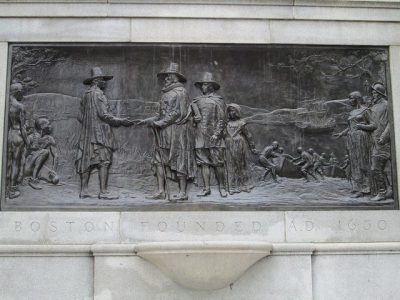Statues, national monuments, and settler-colonialism: Connections between public history and policy in the wake of Bears Ears and Grand Staircase-Escalante
18 December 2017 – Rose Miron

Boston Founders Memorial. In the scene William Blackstone, the first settler of Boston, is greeting John Winthrop, the first governor of the Massachusetts Bay Colony. Native Americans watch the scene, which includes Ann Pollard, the first white woman to land in Boston. An allegorical figure representing Boston watches from the far right. Photo credit: ctmonuments.net
In the past three months, Interior Secretary Ryan Zinke has made statements about both statues to settler-colonialism and national monuments that protect important indigenous sites. First, in October, he was asked about the possibility of taking down Confederate monuments on federal land. “Where do you start and where do you stop?” he asked, further supporting his position by saying “It’s a slippery slope. If you’re a native Indian, I can tell you, you’re not very happy about the history of General Sherman or perhaps President Grant.”
Just two months later, President Trump acted on Zinke’s recommendation to shrink multiple national monuments, reducing Bear Ears National Monument by 85% and Grand Staircase-Escalante National Monument by 47%, both of which include culture landscapes that remain sacred to numerous Native nations including the Hopi, Navajo, Uintah and Ouray Ute, Ute Mountain Ute, and Zuni. Though they may seem unrelated, Zinke’s statements and policy recommendations reveal a key connection between public history and policy making.
In his statement about Sherman and Grant, Zinke rightly points out an inherent problem with statues: their reductive nature leaves little room to communicate nuanced histories, and one person’s hero is likely another’s oppressor. After all, people and histories are complicated. Indeed, if we take down all the statues to white leaders who’ve enacted settler-colonialism violence, it is a slippery slope and we’ll be taking down a lot of statues. But that isn’t the problem that Zinke and others in the Trump administration are most concerned about. For them, the issue is that taking down these statues would force us to recognize that the founding of our nation is based on the dispossession of Native peoples, an acknowledgement that would fundamentally undermine many of their policies. Indeed, their recent decision to shrink both Bears Ears and Grand Staircase-Escalante, a move that ignored Native land claims and important sacred sites, rests on a failure to acknowledge the historic and ongoing dispossession of Native peoples and their rights as sovereign nations. Even if Zinke himself doesn’t realize it, his statements about statues are in direct support of his policies in Indian Country—both advocate for the continued erasure of settler-colonial histories and thus Native sovereignty.
The State of Settler-Colonial Statues
According to the Smithsonian Institution’s database of outdoor sculptures, there are nearly ninety Christopher Columbus statues across the country, nearly forty monuments to Lewis and Clark, and another nearly ninety memorials to “explorers.” This doesn’t begin to cover statues to other white leaders that supported settler-colonialism such as Grant and Sherman, who both led troops in “Indian Wars,” nor does it include statues that feature Indian peoples themselves, which according to the Smithsonian’s database, number more than 250. Looking through the images and descriptions, clear patterns emerge. Of the 258 statues in the database that represent American Indian history, 156, or nearly two-thirds of them, feature Indians within groups of white settlers. In these narratives, Indians are typically presented without tribal designations or names, conflating them as useful guides, antagonists, and props in larger narratives about white settlers and the progress of the U.S. nation-state. In other words, settler-colonial statues go far beyond Columbus, Sherman, or Grant; the slope is much more slippery than Zinke likely realizes.
These representations are ingrained into our national identity and collective heritage, and because of the reductive nature of monuments, they often lack the nuance that telling these complicated historical narratives requires. Instead of communicating a complicated history that might narrate transformation and violence in indigenous homelands, these monuments are taken in quickly by those who pass by, and they typically position Indians as an essential, but not central part of our nation’s history. In monuments like The Founders Memorial in Boston, Massachusetts, unnamed Indians are positioned within a group of white settlers. In Syracuse, New York, a not-so-subtle depiction of violence features Christopher Columbus “atop a tall shaft that is adorned around the top with bronze heads of Native Americans.” Even the U.S. Capitol Senate wing features a marble sculpture called The Progress of Civilization, which displays an Indian family and gravesite positioned opposite figures of a globe, a student and teacher, and a merchant with a box of goods, among other things. The contrast is meant to “symbolize the advantages of civilization and liberty.”

“Progress of Civilization” sculpture. Photo credit: Architect of the Capitol
Sculptures and monuments like these are hardly unique. Instead, they decorate our parks, adorn the walls of our government buildings, and serve as tourist attractions throughout our cities. For every citizen that walks past them, every senator that stops to glance at the scene portrayed, and every tourist who stops to take a photo, these statues and monuments celebrate a clear message: white settlement, and thereby Indian erasure, is an essential part of our nation’s progress. While they acknowledge the presence of Indians in our early history, they rarely depict settler-colonial violence, and thus allow white Americans to imagine settler-colonialism as something inevitable that happened firmly in the past rather than something that’s ongoing as is evident in policy moves like shrinking Bears Ears and Grand Staircase-Escalante.
The Stakes with Statues and Policy Making

Protesters gathering to “Defend the Sacred” against the Dakota Access pipeline, February 2017. Photo credit: LATimes High School Insider
Though it’s tempting to see these depictions as harmless representations of history, or as Zinke put it in his interview with Breitbart, something that might help us learn how we got here and how to create a better future, remember this: the same government officials who walk past The Progress of Civilization every day are the policymakers that refused to respect tribal sovereignty in land development projects like the Dakota Access Pipeline. They are the same representatives who are refusing to uphold Ojibwe treaty rights to hunt, gather, and fish in their ceded homelands by turning a blind eye to new pipelines that could destroy sensitive wild rice beds. They are the same politicians who routinely attempt to cut funding for tribal programs, like Zinke’s support of a proposal that would cut $64.4 million from Indian affairs education programs. In other words, these statues are not innocent. They reinforce common representations to which we are regularly exposed in popular culture, sports mascots, and Thanksgiving narratives. Moreover, they are especially problematic because as Professor Gabriel A. Reich, an expert on historical consciousness surrounding the Civil War, argues, while they affect everyone differently, monuments influence our collective understanding of who should be revered and thus normalize who matters and who has power in our society. They profoundly shape the way our citizens and elected representatives such as Zinke and President Trump see American Indian nations in present-day society, and their opinions about to what extent these nations matter and hold power.
The influence of these representations shows in their policies and practices. In that sense, it’s no surprise that President Trump almost immediately approved permits that allowed construction on the Dakota Access Pipeline. It’s not shocking that Zinke positions taking down statues to white leaders such as Grant and Sherman as a place where we’ve gone too far, while he drafted a policy recommendation to shrink Bears Ears and Grand Staircase-Escalante National Monuments that was enacted this month by President Trump. Zinke’s statements about settler-colonial monuments and his policy recommendations in Indian Country are in perfect harmony: they advocate for the erasure of settler-colonial histories by supporting monuments that celebrate white settlement, while continuing the process of ignoring tribal sovereignty and taking indigenous land.
~ Rose Miron is a Ph.D candidate in the department of American Studies at the University of Minnesota.
*This post is in response to the Editors’ call for follow-up pieces about the effects of the 2016 election.



